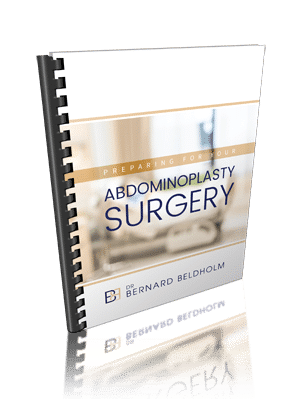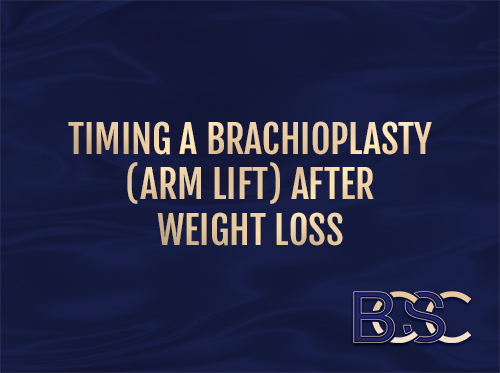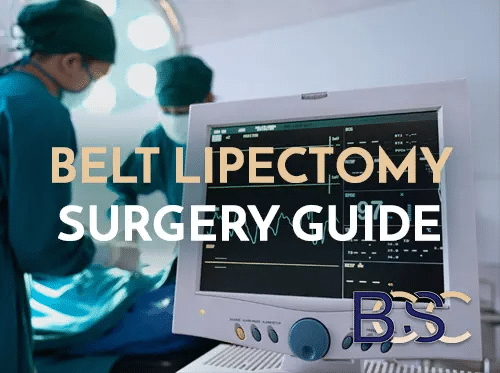Customised Approaches for Lower Body Readjustment: Abdominoplasty , Belt Lipectomy, Fleur-de-Lis Abdominoplasty, and Combined Procedures
Patients looking for lower body readjustment can consider traditional abdominoplasty (tummy tuck), belt lipectomy, Fleur-de-Lis abdominoplasty, or a combination of procedures.
Massive weight loss leads to loose skin in the lower body, especially the abdomen, flanks, hips, and buttocks. The loose skin affects the patient’s aesthetics and can cause functionality difficulties, which calls for removal.
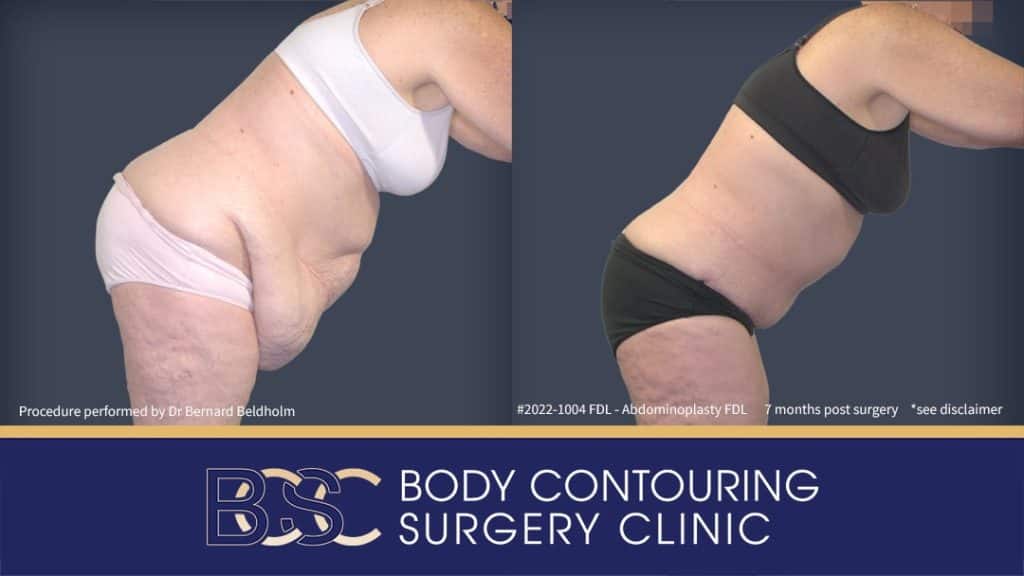
Fleur de lis abdominoplasty before & after | Operation performed by Dr Bernard Beldholm
Face blurred for privacy
Disclaimer: Operation performed by Dr Bernard Beldholm. Adult content, surgery has risks; individual results vary, seek 2nd opinion. Please see the full disclaimer.
The primary surgical procedures to treat loose skin in the lower body include tummy tuck (abdominoplasty), belt lipectomy, Fleur-de-Lis abdominoplasty, or a combination of the procedures.
Each of these surgeries is suitable based on the volume of loose skin a patient presents, and its location. As such, each patient desiring the removal of loose skin from the lower body is suited for a different surgical procedure. However, most patients find it challenging to determine a suitable procedure to meet their goals. If you don’t know where to begin, this guide walks you through the primary procedures for lower body readjustment, their benefits, limitations, and suitability.
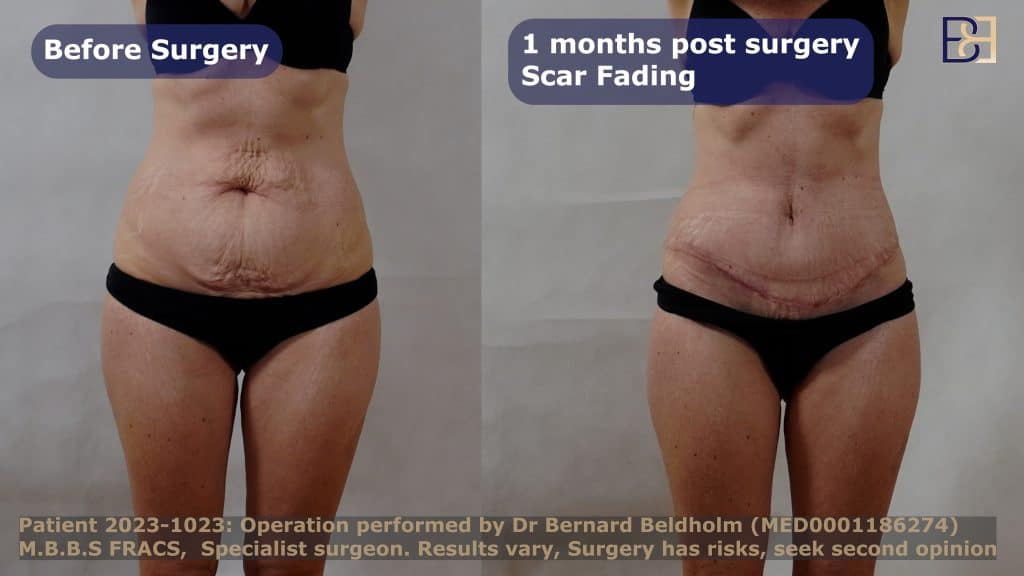
Traditional Abdominoplasty
Abdominoplasty is a surgical procedure designed to correct loose, hanging skin around the abdomen. It also treats loose and separated abdominal muscles (diastasis recti) and tightens the core. Though abdominoplasty is generally thought of as an aesthetic operation, it may also be performed for reconstructive reasons since it corrects certain medical conditions.
Overview of the Procedure
Traditional abdominoplasty is characterised by a horizontal incision across the waistline, a few inches over the pubic area. The length of this abdominal incision may vary from one patient to another. However, the most important determinant is the amount of skin that needs to be removed. The longer the incision site, the more extensive the abdomen skin removed.
Traditional abdominoplasties take about two to three hours in the operating room. However, this may be longer if the specialist surgeon incorporates liposuction (suction-assisted lipectomy) into the procedure. Liposuction liquefies the fatty tissue in the desired region and removes it out of the body through suction.
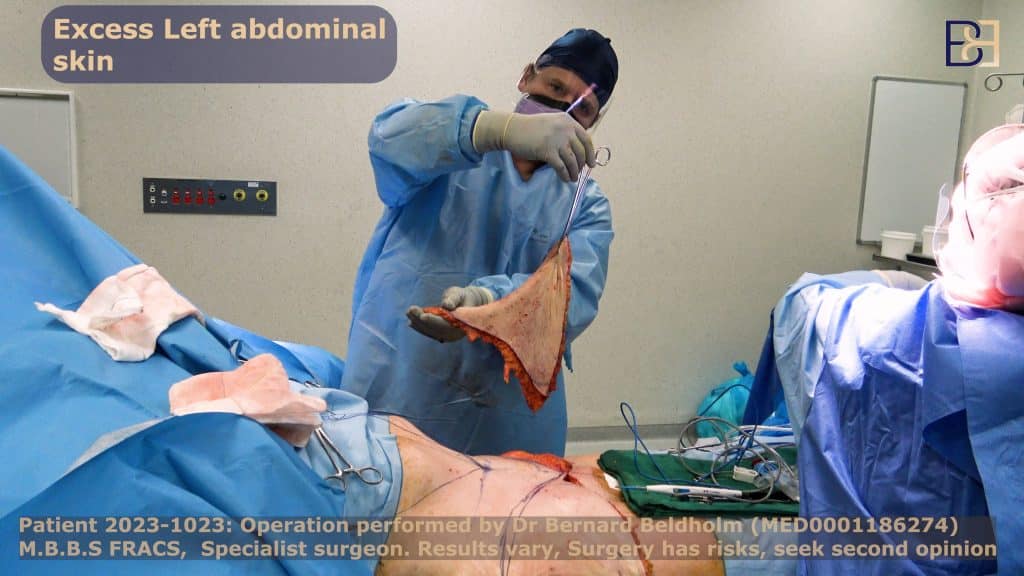
Dr Beldholm removing excess skin
Liposuction (suction-assisted lipectomy) is effective in patients with accumulated internal fat that abdominoplasty cannot treat adequately. Body Contouring Surgery Clinic uses VASER liposuction (suction-assisted lipectomy), a more specialised liposuction (suction-assisted lipectomy) technique, to ensure effective fat removal. VASER liposuction (suction-assisted lipectomy) is an advanced liposuction (suction-assisted lipectomy) method that uses ultrasound waves to break down and liquefy fat cells, facilitating easier removal. This technique offers a more refined and controlled fat extraction process compared to traditional liposuction (suction-assisted lipectomy), which is more invasive and causes more damage to surrounding tissue.
Traditional abdominoplasty leaves a horizontal scar in the place of the incision. The scar can easily be hidden by underwear and most swimsuits and fades over time.
Who is Suitable for Traditional Abdominoplasty?
The ideal candidates for traditional abdominoplasty include people with loose skin on the lower abdomen. It is also recommended for patients who have separated abdominal muscles, a common phenomenon in postpartum and weight loss patients.
A scientific study on abdominoplasty procedure notes, “[p]atients with minimal to moderate subcutaneous fat and minimal to moderate abdominal wall laxity which is located primarily in the infra-umbilical region are candidates for the mini-abdominoplasty. Patients with excessive skin laxity, fat, and abdominal wall weakness are ideal candidates for full abdominoplasties.”
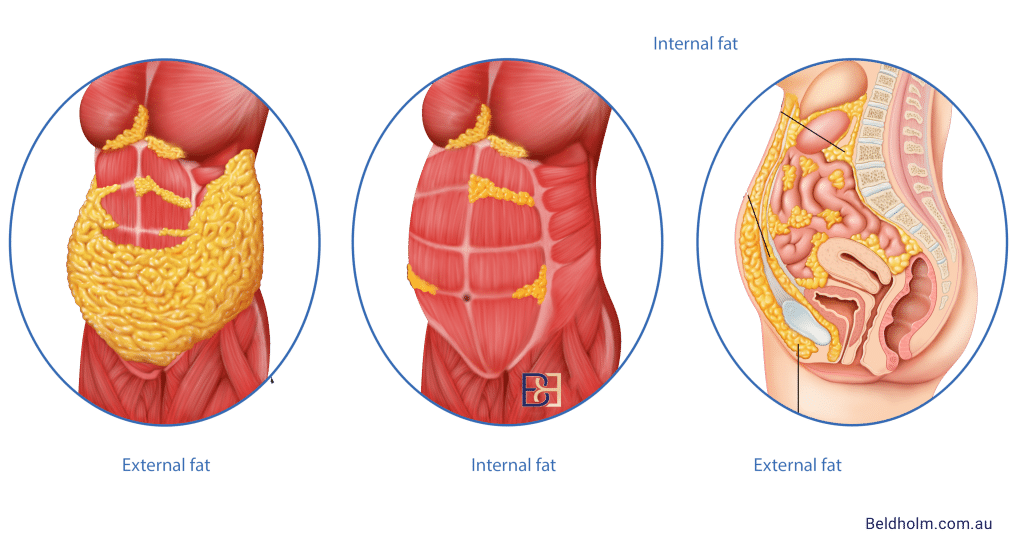
Internal fat can not be treated with body contouring surgery. Weight loss is the primary method for removing this.
Benefits
- Abdominal shape: Loose skin in the abdomen affects one’s physical aesthetics. Abdominoplasty removes the loose skin and tightens the abdomen, resulting in an aesthetically pleasing contour.
- Repairing Weak/separated abdominal muscles (Diastasis recti): Separated/weak abdominal muscles are common in postpartum patients and those who have undergone massive weight loss following bariatric surgery. This condition, known as diastasis recti, can cause pain and discomfort. Abdominoplasty repairs the separated abdominal muscles (Diastasis recti) and also strengthens the core.
- Targets excess abdominal skin complications: Excess abdominal skin results in further complications such as skin chafing, infections, urinary complications, back pain, and poor posture, and can have a negative effect on one’s sex life.
Limitations
Amount of excess skin being removed: Standard abdominoplasty removes a moderate quantity of excess skin on the lower abdomen only, as opposed to other procedures that remove excess skin on the upper abdomen, flanks, back, sides, and buttocks. Additionally, the excess skin is confined to the front of the torso only, and it does not repair loose skin in other parts of the lower body.
Risks and Complications
As with any major surgery, Traditional Abdominoplasty surgery carries risks. A major operation, potential complications include:
- Wound infection
- Seroma
- Haematoma: a collection of blood pooling outside of a blood vessel
- Anaesthesia risks
- Asymmetry
- Bleeding
- Deep vein thrombosis, cardiac and pulmonary complications
- Fat necrosis: fatty tissue death
- Numbness or other changes in skin sensation
- Persistent pain
- Poor wound healing
- Possibility of revisional surgery
- Recurrent looseness of skin
- Skin discoloration and/or prolonged swelling
- Skin loss
- Unfavourable scarring
Belt Lipectomy (Lower Body Lift)
A belt lipectomy, AKA lower body lift, circumferential abdominoplasty, or 360 degree body lift, is a cosmetic surgery that “involves the removal of excess skin and fat around the lower trunk.”
Overview of the Procedure
Compared to abdominoplasty, a circumferential abdominoplasty an extremely invasive surgery. Not only does it involve a longer surgical time, but patients remain in the hospital for five to seven days following surgery.
A belt lipectomy surgery targets excessive skin on both the front and back of the patient after substantial weight loss. The two-sided procedure involves the patient starting in the prone position (laying face down). The first half of the surgery involves the specialist surgeon making an incision across the lower back to remove the excess skin and fatty tissues across the hips, lower back, sides, and buttocks. In many cases, the surgeon may incorporate liposuction to remove excess tissue.
Once the back side is complete and the specialist surgeon closes the incision, the patient is rotated to lie in the supine position (face up). The specialist surgeon makes a second incision horizontally, from hip-to-hip, to remove excess abdominal skin. The specialist surgeon then removes the loose abdominal skin and repairs separated abdominal muscles.
Who is Suitable for a Belt Lipectomy?
A belt lipectomy is suitable for patients who have lost a significant amount of weight either after bariatric or other weight loss surgery resulting in loose skin all around the lower trunk on the abdomen, flanks, buttocks, and hips.
The aim of removing the loose skin may be to eliminate functional impairment and complications such as skin infections, which may occur because of the excess skin on the lower trunk.
It is important to note that candidates for this procedure are patients who’ve reached their weight loss goals. Like abdominoplasty, a belt lipectomy is not weight loss surgery and should never be considered a substitute for bariatric surgery or healthy lifestyle changes. However, it is important to note that the ideal patient should attain a stable weight before surgery.
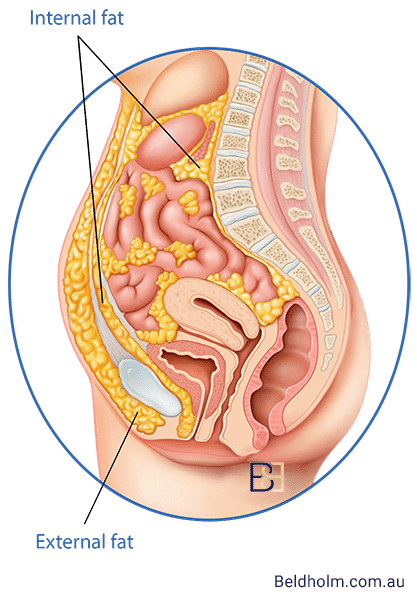
Benefits
- Loose skin all-round the lower trunk: Belt lipectomy treats skin, not just on the abdomen but also on the entire lower trunk. Therefore, the surgeon may treat multiple concerns with just one procedure.
- Abdominal shape: A circumferential abdominoplasty covers 360 degrees around the lower trunk. The result is a dramatic change in abdomen.
- Complication management: The loose skin in the entire trunk may be associated with various complications such as skin infections, urinary incontinence, skin chafing, and many others.
Recovery Timeline
Healing from belt lipectomy surgery doesn’t happen overnight. It involves a long recovery during which time the patient must refrain from driving, exercising, and in most cases, working for several weeks. So patients must prepare ahead of time to arrange for child care, pet care, time off from work, and making arrangements for someone to drive them to and from follow-up appointments. That’s something Dr. Beldholm always tells his patients upfront.
Limitations
- Longer surgical time: Belt lipectomy is invasive and complex because it deals with loose skin of the whole trunk. That increases the surgery time.
- Longer recovery time: Recovery time is longer in patients who undergo belt lipectomy because the procedure is much more invasive with an extensive region of incision.
- Excessive scarring: In a belt lipectomy, the specialist surgeon makes an extensive incision around the lower trunk. This leaves behind an extensive scar post-recovery.
Risks and Complications
As with any major surgery, belt lipectomy surgery carries risks. Because a lower body lift is a major operation that targets several body areas at once, it has slightly higher complication rates than surgeries like abdominoplasty. Potential complications include:
- Wound infection
- Seroma: Excess fluid building up under the skin which require drainage tubes
- Haematoma: a collection of blood pooling outside of a blood vessel
- Anaesthesia risks
- Asymmetry
- Bleeding
- Deep vein thrombosis, cardiac and pulmonary complications
- Fat necrosis: fatty tissue death
- Numbness or other changes in skin sensation
- Persistent pain
- Poor wound healing
- Possibility of revisional surgery
- Recurrent looseness of skin
- Skin discoloration and/or prolonged swelling
- Skin loss
- Prominent scars
Fleur-de-Lis Abdominoplasty
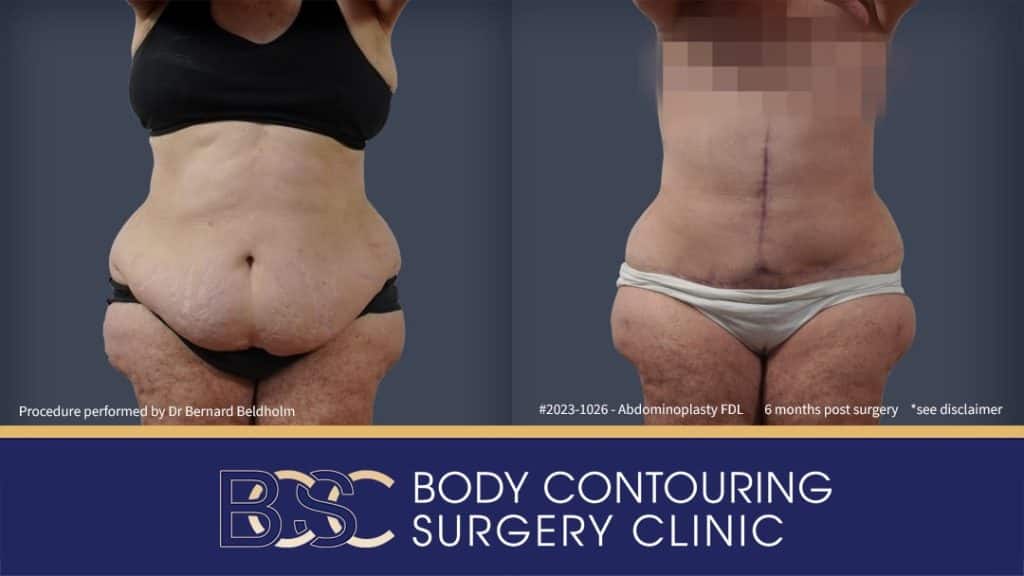
Fleur de lis abdominoplasty | vertical and horizontal incisions | performed by Dr Beldholm
Nipple-areola covered to comply with No nudity
Disclaimer: Operation performed by Dr Bernard Beldholm. Adult content, surgery has risks; individual results vary, seek 2nd opinion. Please see the full disclaimer.
After significant weight loss, patients may present with significant loose skin on the entire abdomen, with both horizontal and vertical skin laxity. This can be challenging with traditional abdominoplasty, which only treats horizontal skin laxity.
Fleur-de-Lis abdominoplasty is a special abdominoplasty procedure that removes excess abdominal skin on both the upper and lower abdominal areas. Also called coset lipectomy or vertical abdominoplasty, Fleur-de-Lis abdominoplasty is common in post-massive weight loss patients once they have reached a healthy weight and are no longer planning substantial weight loss.
A study on Fleur-de-lis abdominoplasty notes, “[v]ertical abdominoplasty is an effective cosmetic procedure to correct abdominal contour abnormalities in individuals with excessive soft tissue in both the vertical and transverse orientation.”
Fleur-de-Lis abdominoplasty is named from its incision pattern, which resembles an “Irish flower” when it is partially closed.
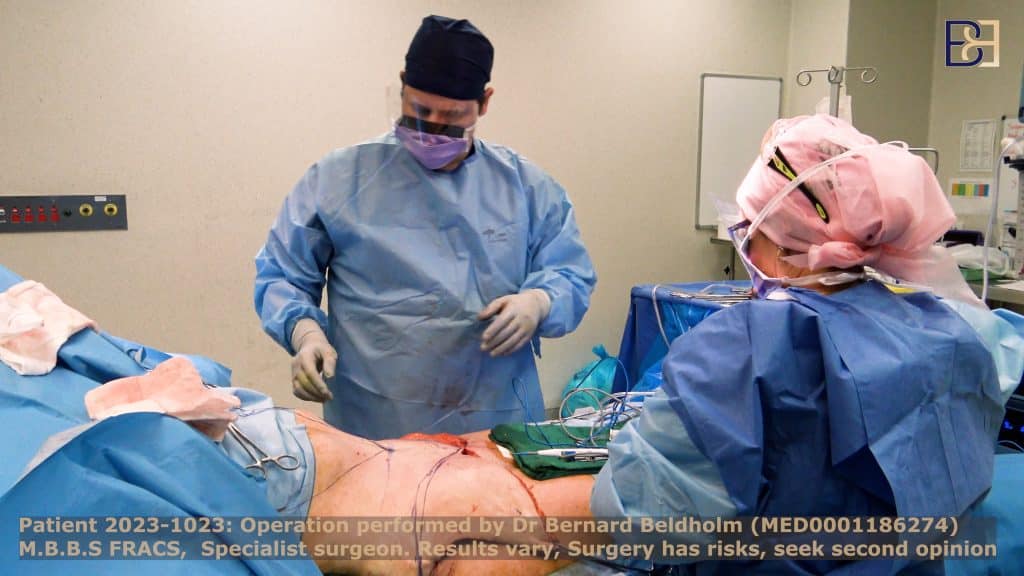
Dr Beldholm performing VASER liposuction during extended tummy tuck
Overview of the Procedure
Fleur-de-Lis abdominoplasty involves making a horizontal and vertical incision. The horizontal incision extends across the waistline, similar to a traditional abdominoplasty incision. The vertical incision runs upwards from the groyne region where it meets the horizontal incision up to the sternum. The incisions form an “anchor” or “inverted T” pattern.
Fleur-de-Lis abdominoplasty surgery is quite invasive and complex; hence it takes three to five hours. During the surgery, the specialist surgeon removes the vertical and horizontal skin laxity, underlying tissue, and separated abdominal muscles (diastasis recti).
In many instances, the Fleur-de-Lis abdominoplasty also involves belly button repositioning. The specialist surgeon may also include liposuction (suction-assisted lipectomy) if the patient has excess fat in the abdominal area.
Who is Suitable for Fleur-de-Lis Abdominoplasty?
Fleur-de-Lis abdominoplasty is suitable for patients with horizontal and vertical skin laxity that cannot be treated adequately through standard abdominoplasty. You should note that traditional abdominoplasty does not target vertical skin laxity. A PubMed study notes, “[i]deal candidates are patients with upper abdominal skin laxity who may not achieve an adequate aesthetic result with transverse-only excision.”
Patients with horizontal and vertical skin laxity include massive weight loss patients following weight loss surgeries. In addition, post-pregnancy women are also the best candidates for Fleur-de-Lis abdominoplasty.
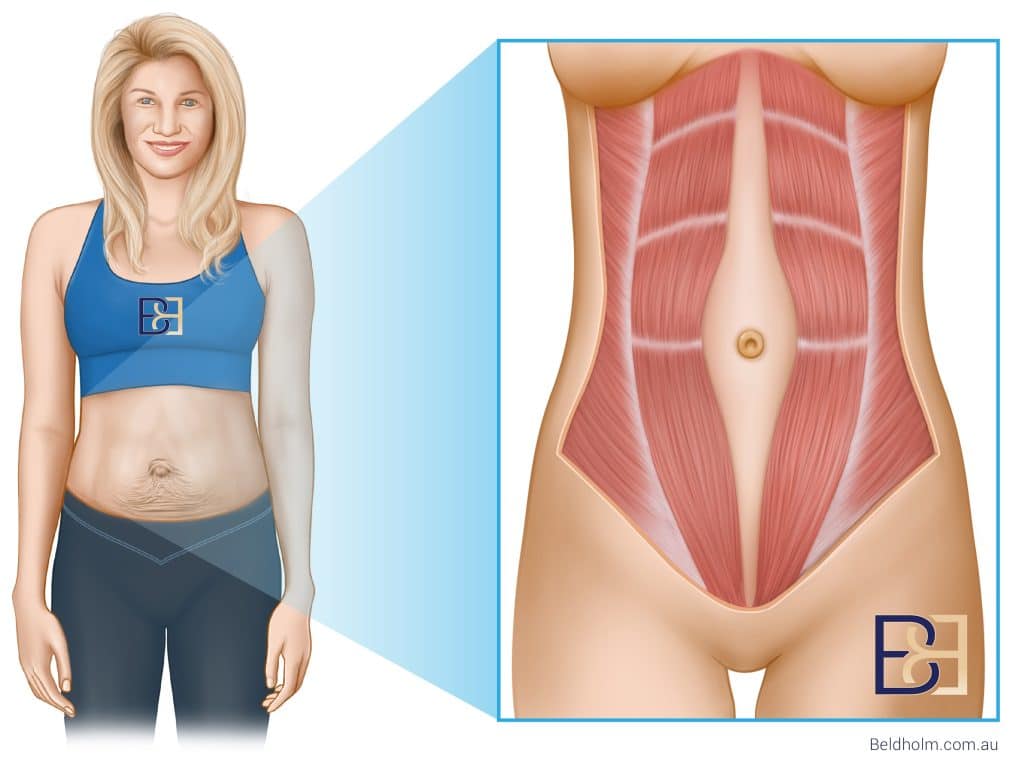
Separated abdominal muscle repair
Benefits
- Removes significant loose skin
- Managing vertical skin laxity
- Strengthening of the core
- Body functionality
Limitations
- Increased surgery period
- Longer recovery period
- Extensive and prominent scarring
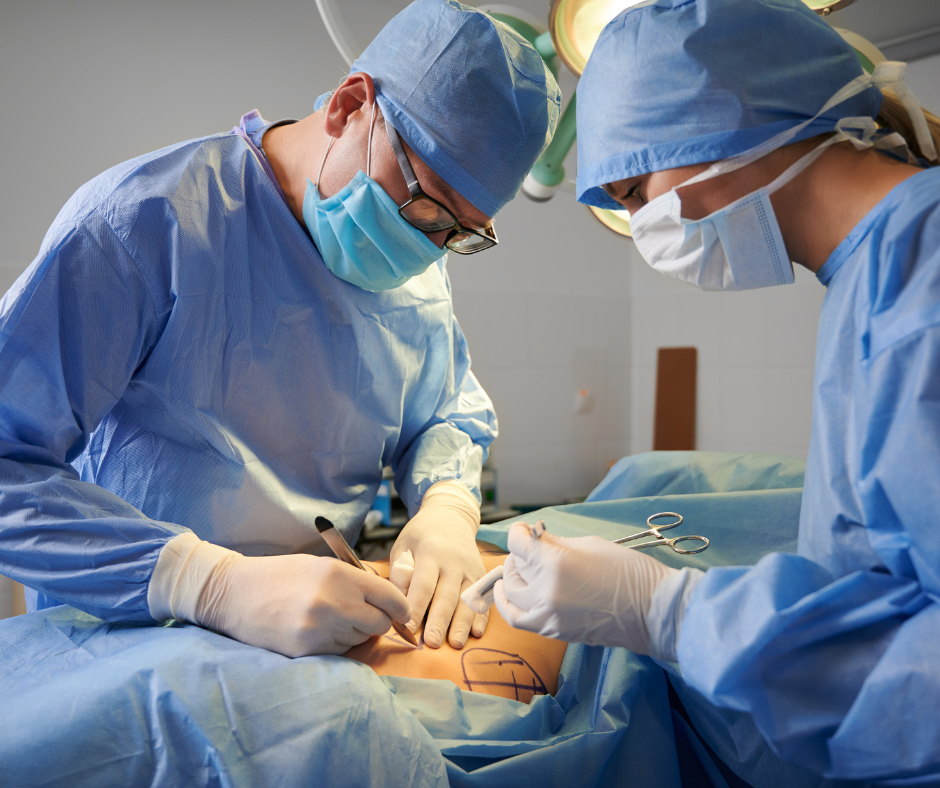
Combined FDL and belt lipectomy surgery
Combined Fleur-de-Lis Abdominoplasty and Belt Lipectomy
Fleur-de-Lis abdominoplasty can be combined with belt lipectomy procedures.
A study on Belt lipectomy notes, “[t]his comprehensive procedure often includes formal abdominoplasty, a “tummy tuck,” which entails extensive undermining through the epigastric region, relocation of the umbilicus, and rectus diastasis plication. Belt lipectomy may be coded as an additional procedure alongside abdominoplasty.”
Overview of the Procedure
The combined procedure begins with the patient lying in the prone position (face down), with the surgeon making an incision site across the lower back. Once the back side is complete and the specialist surgeon closes the incision, the patient is rotated to lie in the supine position (face up). The qualified surgeon makes a second incision horizontally, from hip-to-hip, to treat excess abdominal region skin. The specialist surgeon may also reposition the belly button and repair loose abdominal muscles (diastasis rect).
Because this is a very invasive procedure, the patient will spend at least five days in the hospital for observation.
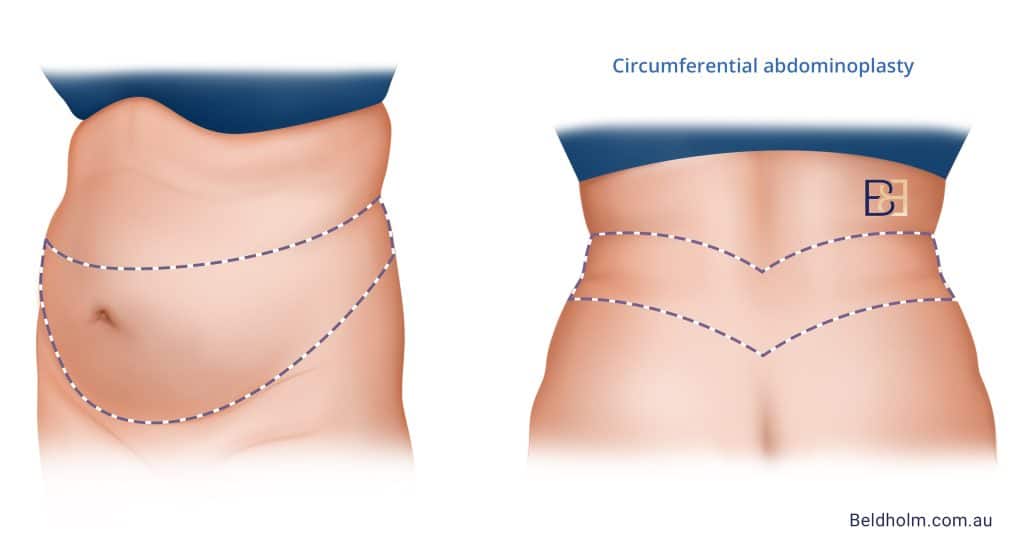
Belt lipectomy surgery
Advantages
- One anaesthesia session: Because the patient undergoes one procedure instead of undergoing two procedures separately, only one anaesthesia session is involved, reducing potential risks.
- Removal of a large amount of redundant skin: Combining the two procedures helps target the lower trunk and the whole abdomen.
- One recovery period: Recovery after a surgical procedure may be exhaustive and long. Therefore, a combined procedure allows you to undertake one recovery instead of two.
Limitations
- Increased surgical risks: Every surgical procedure is associated with a risk of developing complications during and after the procedure. Combining two invasive procedures significantly increases the risks of complications.
- Extensive scarring: Belt lipectomy leaves a abdominoplasty scar around the beltline, while the Fleur-de-Lis abdominoplasty leaves a scar in the lower and upper abdomen. Therefore, the patient will have a scar along the belt line and another at the front side of the midsection.
Risks and Complications
As with any major surgery, FDL surgery carries risks. Surgical complications include:
- Wound infection
- Seroma: Excess fluid building up under the skin which require drainage tubes
- Haematoma: a collection of blood pooling outside of a blood vessel
- Anaesthesia risks
- Massive swelling
- Asymmetry
- Bleeding
- Deep vein thrombosis
- Cardiac and pulmonary complications
- Numbness
- Persistent pain
- Poor wound healing
- Possibility of revisional surgery
- Recurrent loose skin
- Skin discoloration
- Prolonged swelling
- Skin loss
- Prominent scarring
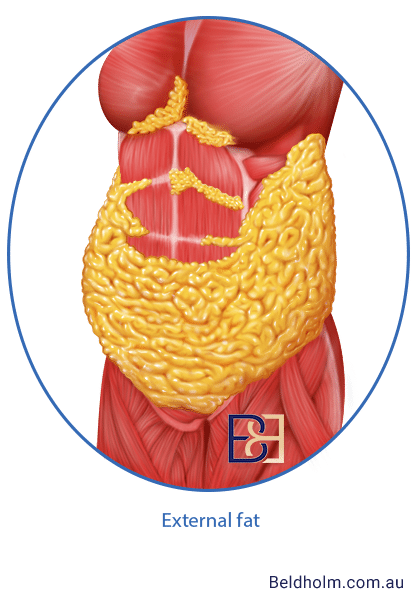
Decision-Making Considerations
These are some of the considerations in choosing a type of procedure that removes excess skin of the lower body:
- Degree of skin laxity: The degree of skin laxity determines the extent of the surgical procedure, with patients with horizontal skin laxity confined to traditional abdominoplasty. Horizontal and vertical laxity in the abdomen make patients better candidates for Fleur-de-Lis abdominoplasty. Belt lipectomy is a more suitable choice for those with skin laxity in the flanks, hips, buttocks, abdomen, and lower back.
- Desired result: Different patients have different goals for excising skin in the lower body. Some want subtle changes in the abdomen, while others want dramatic contouring. This influences the choice of the right procedure.
- Scar tolerance: Many factors influence post-surgical scarring, including a person’s predisposition to scarring and family history. Patients who tend to form unsightly visible and prominent scars after the abdominoplasty or tummy tuck surgery should avoid surgical procedures that require extensive incisions.
- Recovery time: After each surgery, the patient must take some time off from daily life to heal. The higher the surgical site invasiveness, the longer the recovery period. For example, patients who have a belt lipectomy need more time to heal than the standard abdominoplasty patients. Additionally, combining two invasive surgeries increases the recovery time far more, even though technically only one recovery period is actually involved. It’s a trade-off: one more complicated recovery vs. two recovery periods, each of which would be somewhat less intense, but still involve two extended periods of downtime, severe pain, and risks.
- General health: When going through a surgical procedure, it is very essential that one be in optimal health as poor health greatly increases the risk for complications during and after surgery. Patients should delay surgery in the case of any serious medical conditions, including if you were in good health at the time of surgical planning but it deteriorated before the time of surgery. To prevent serious complications, it’s critical to keep the specialist apprised of any physical concerns or medical matters.
Final Take

Loose skin of the lower body may be functionally limiting, and may also result in complications.
The key procedures to treat loose skin in the lower body include tummy tuck (abdominoplasty), belt lipectomy, and Fleur-de-Lis abdominoplasty. This article was written to provide potential surgical candidates with an overall description of these procedures, including the recovery timeline, potential risks, benefits, and suitability for different sets of candidates.
For additional information on how to treat loose skin in the lower body, or your suitability for a specific procedure, book a consultation with Body Contouring and Surgery Clinic.
Resources
- Mayo J, Cape JD. Belt Lipectomy. [Updated 2024 Jun 1]. In: StatPearls [Internet]. Treasure Island (FL): StatPearls Publishing; 2024 Jan-.
- Aly, A., & Mueller, M. (2014). Circumferential truncal contouring: the belt lipectomy. Clinics in plastic surgery, 41(4), 765–774.
- Regan JP, Casaubon JT. Abdominoplasty. [Updated 2023 Jul 24]. In: StatPearls [Internet]. Treasure Island (FL): StatPearls Publishing; 2024 Jan-.
- Aly, A. S., Cram, A. E., Chao, M., Pang, J., & McKeon, M. (2003). Belt lipectomy for circumferential truncal excess: the University of Iowa experience. Plastic and reconstructive surgery, 111(1), 398–413.
- Mitchell, R. T., & Rubin, J. P. (2014). The Fleur-De-Lis abdominoplasty. Clinics in plastic surgery, 41(4), 673–680.
- Mayo, J., & Cape, J. D. (2024). Belt Lipectomy. In StatPearls. StatPearls Publishing.
- Mendes, F. H., Viterbo, F., & Moragas, W. R. (2024). Finesse in Fleur-de-lis Abdominoplasty. Clinics in plastic surgery, 51(1), 81–93.
- Ziegler, U. E., Ziegler, S. N., & Zeplin, P. H. (2017). Modified Fleur-de-lis Abdominoplasty for Massive Weight Loss Patients. Annals of plastic surgery, 79(2), 130–134.
- Friedman, T., O’Brien Coon, D., Michaels V, J., Purnell, C., Hur, S., Harris, D. N., & Rubin, J. P. (2010). Fleur-de-Lis abdominoplasty: a safe alternative to traditional abdominoplasty for the massive weight loss patient. Plastic and reconstructive surgery, 125(5), 1525–1535.
- Matarasso, A., Matarasso, D. M., & Matarasso, E. J. (2014). Abdominoplasty: classic principles and technique. Clinics in plastic surgery, 41(4), 655–672.
- Bartow MJ, Raggio BS. Liposuction. [Updated 2023 Feb 14]. In: StatPearls [Internet]. Treasure Island (FL): StatPearls Publishing; 2024 Jan-.
- Hoyos, A. E., & Millard, J. A. (2007). VASER-assisted high-definition liposculpture. Aesthetic surgery journal, 27(6), 594–604.
